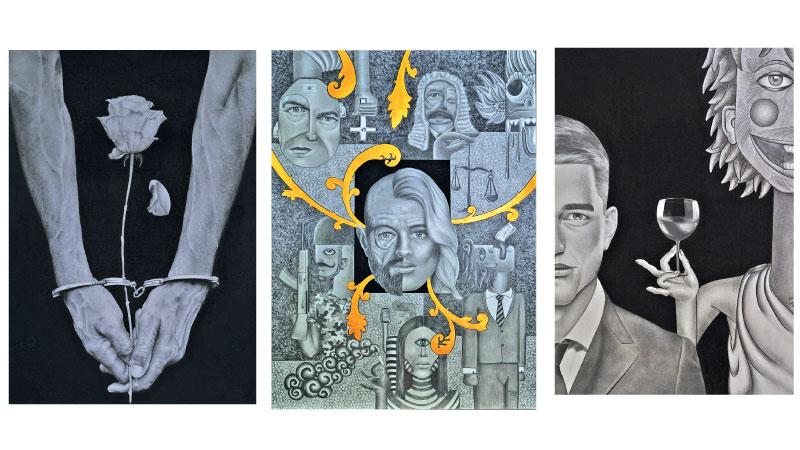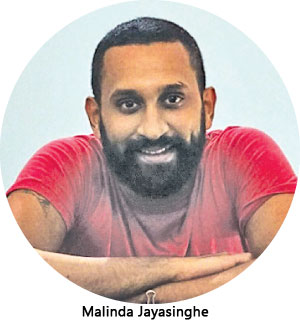
 The portraits are severed in half. The figures are split into varying designs. Conflict is the keyword which comes to mind when scrutinizing Malinda Jayasinghe’s paintings. It is apparent that he is not just trying out portraiture or life drawing; he is attempting to say something with intensity and passion. I speak to Malinda with the intention of locating the ‘voice’ behind his art.
The portraits are severed in half. The figures are split into varying designs. Conflict is the keyword which comes to mind when scrutinizing Malinda Jayasinghe’s paintings. It is apparent that he is not just trying out portraiture or life drawing; he is attempting to say something with intensity and passion. I speak to Malinda with the intention of locating the ‘voice’ behind his art.
Malinda says he does not possess an academic background in fine art. “As a child I used to draw and paint a lot but I never did Art as a subject even for my O/Ls. I opted for a completely different stream of subjects in Accounting and Finance. After I completed my higher studies in Australia, I came back to Sri Lanka and worked for the stock market and later for a multinational company. My work had nothing to do with art but I used to draw and paint on my own regularly.”
In 2019 Malinda had taken a leap of faith, a daring risk and decided to quit the corporate world to pursue a full time career as an artist. He says his understanding and perceptions changed drastically when he took a course in art history at the Theertha Academy. Malinda had been able to find answers to his unanswered questions which were pent up throughout his life. “That course gave me the push I needed to launch myself into the world of art. I learnt that art was not just about drawing and painting and that conceptualization required an in-depth knowledge of philosophy, ideology and being able to analyse critically. My perceptions were greatly influenced by what I learnt and I realized that what I wanted to say with my art could not be categorized or compartmentalized in anyway. My mind opened to a vast world of many viewpoints, angles and aspects.”
Malinda declares that his art was influenced by Picasso, Cubism, Surrealism, New Cubism and contemporary artists such as George Condo and Jono Dry. Malinda deconstructs and reconstructs the human form in order to express issues which he feels should be emphasized in the current context. “My art is representational but not realistic. It is not classical representation but contemporary representation that I opt for.”
“So what are you trying to say?” I probe. Malinda says he attempts to address human nature and human issues; how we are influenced by cultural and traditional dynamics as well as gender, age and perception of beauty. According to Malinda all aspects of the human condition cause some kind of conflict during our existence. An example would be the painting ‘A Portrait in the 21st century’ which showcases how we perceive women and beauty in the current context where we are frequently bombarded by information via social media and main stream media as to how ‘beauty’ should be perceived. ‘I constantly try to challenge and question stereotypical imagery. In my ‘Society’ piece I have portrayed a mixed gendered person, who is young as well as old.
My piece ‘Boys don’t cry’ questions how gender roles and norms are formulated and maintained in society. I question the rigid notions of masculinity and femininity in a particular culture.”
Malinda seems to question all kinds of phenomena that we are compelled to face. Most significantly how we are influenced by capitalism and consumerism. He uses diverse symbols to depict varying aspects and in one painting it is the golden ‘liyawela’: a traditional Sri Lankan motif, with thorns added, which shows how capitalism and consumerism have engulfed us as individuals as well as a society. “My background in marketing has been complemented by the conceptualization process in art. “
I have seen firsthand how in advertising and marketing works we are manipulated and exploited to consume commodities we actually do not need,” Malinda explains.
I ask him about his move from the corporate world to working as a full time career artist. He elaborates by describing a painting he did on Apollo and Dionysus, Apollo symbolizing success and ambitiousness versus Dionysus a symbol of merry making and being carefree. Malinda goes on to say that our culture appropriates success to career success and that in an earlier era almost all the parents wanted their children to become doctors, lawyers or engineers and now parents want their kids to be at the very top of whatever they pursue whether its academics or extracurricular activities. He views his decision to leave the corporate rat race as a conscious and responsible one. ‘I had to lower my financial expectations. I earn some money by doing commission work but I try to be disciplined in my practice. I treat my art as a full time job and am very organized with my schedule. I refrain from wasting any time.”
Malinda is a determined artist with a vision and a mission. In a world where most his age would have chosen a career path of a nine to five job which requires climbing the corporate ladder, he has decided to take the path less trodden. On that path he seems to have embarked on a journey which allows him to be curious and full of wonder. That is what Malinda Jayasinghe’s art and the voice behind the art tells us.
